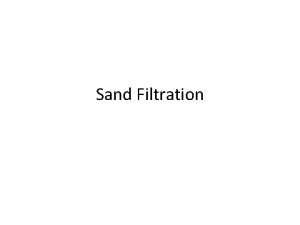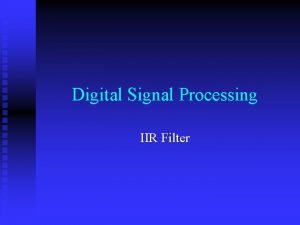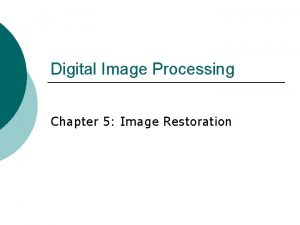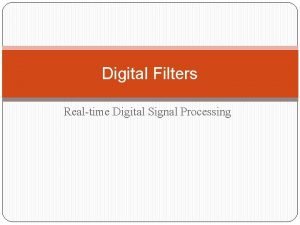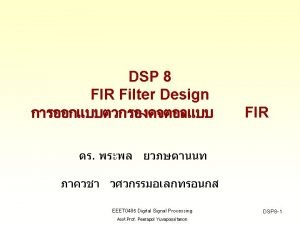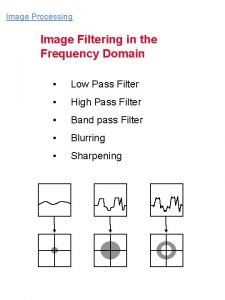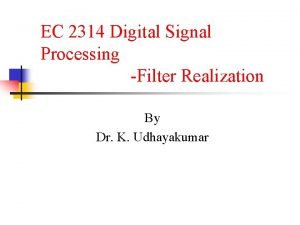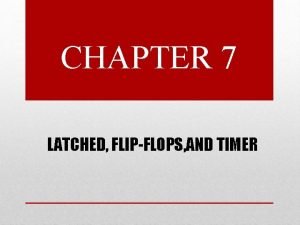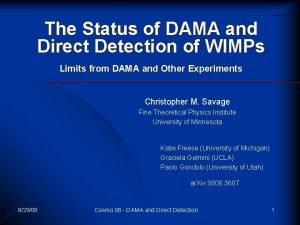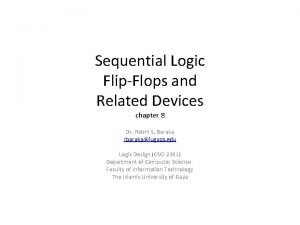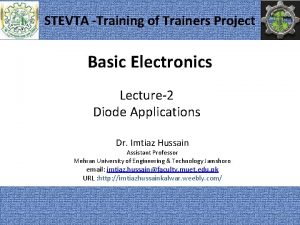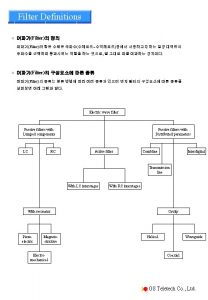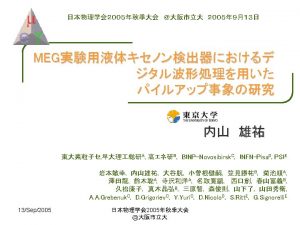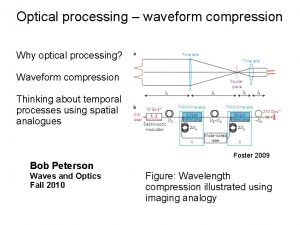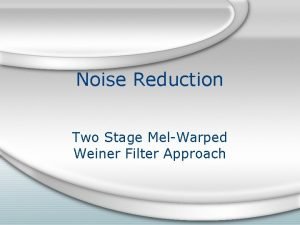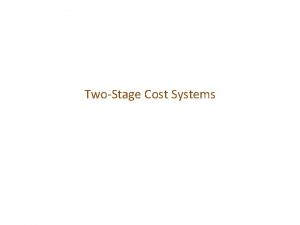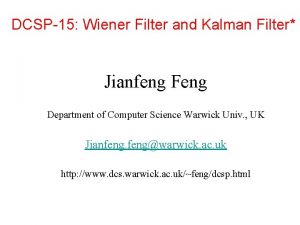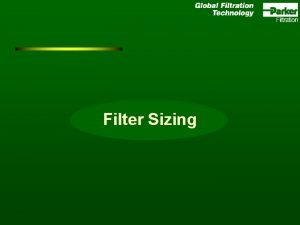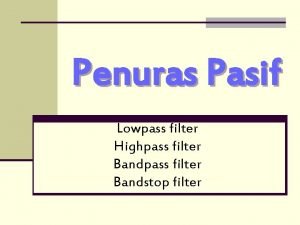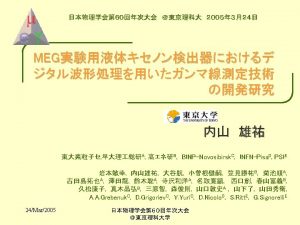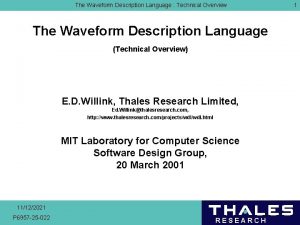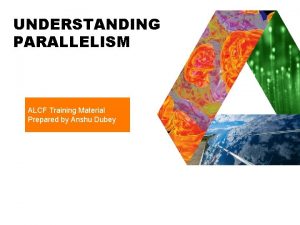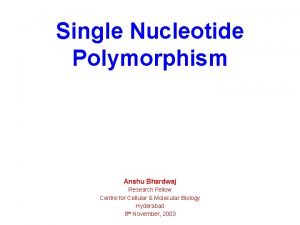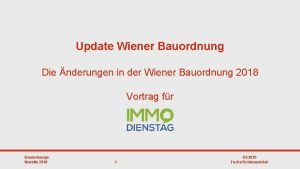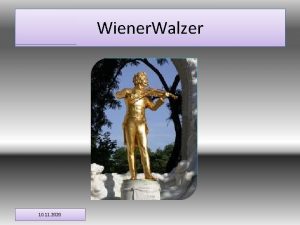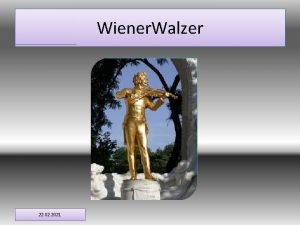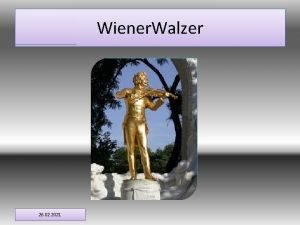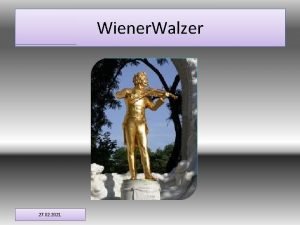TwoStage MelWarped Wiener Filter SNRDependent Waveform Processing Anshu




















- Slides: 20

Two-Stage Mel-Warped Wiener Filter SNR-Dependent Waveform Processing Anshu Agarwal and Yan Ming Cheng, ASRU 1999 Human Interface Lab, Motorola Labs, USA Dusan Macho and Yan Ming Cheng, ICASSP 2001 Human Interface Lab, Motorola Labs, USA 2004/08/17 Presented by Chen-Wei Liu

Outline • Introduction • Two-stage Wiener Filter – Formula – Algorithm • SNR Waveform Processing – Idea – Algorithm • Experiments 2

Introduction • The problem investigated here is that of – speech recognition in an automobile noise environment, where colored noise with intensity as high as or even higher than the input speech is the main characteristic • The performance of conventional speech recognizers – Degrades by more than 50% in typical automobile noise conditions • The automobile noise can be considered as additive – Because it originates from the car’s engine, an opened window, etc. – Many techniques were proposed to subtract the noises from a noise speech signal 3

Introduction • It’s believed that – There is a direct correlation between speech signal strength and speech recognition accuracy – The cleaner the signal, the better the performance • This paper proposes an new approach – Based on the Mel-warped Wiener filter concept – Step 1: coarsely reduce the noise and whiten residual noise – Step 2: wipe the residual noise • By exploiting the correlation characteristics between the speech signal and the white noise 4

Formulation of Mel-Wapred Wiener Filter • The noisy signal with additive noise assumption can be expressed as follows • A Wiener filter is constructed as 5

Formulation of Mel-Wapred Wiener Filter • The mel-warped spectral transfer function of Wiener filter is expressed as – Where m stands for mel-frequency and the warping function • The process of computing the mel-warped power spectrum from an auto-correlation series as Mel-DCT 6

Formulation of Mel-Wapred Wiener Filter • Wiener filtering is performed in the time domain, where noisy signal convolves with the impulse response of the Wiener filter • We refer to the process of converting a melwarped transfer function to a time-domain impulse response as inverse Mel-IDCT 7

Two-Stage Filtering • The approach is to adapt the estimate in time – Based on a silence-speech detector to capture the evolution of the noise spectrum • First stage – Whitens the noise while preserving the speech spectrum unharmed • Second stage – Wipes out the residual white noise by exploiting the auto-correlation characteristics of white noise 8

Two-Stage Filtering 9

System Overview 10

Basic Idea of SWP • The interference noise energy generated by outside sources is relatively constant within the speech period – Therefore, SNR is variable • If we can locate the high SNR period portion and increase its energy or, vice versa… – The overall SNR of given voiced speech segment is enhanced – A front-end based on the SNR-enhanced signal is expected to be more robust 11

Algorithm Description • In SWP, for each frame – A smoothed instant energy contour is first computed • By using Teager energy operator to obtain the instant energy value at each sample • The contour of voiced sounds has quasi-periodic property • For unvoiced sounds, a flatter contour can be observed • Peaks of the smoothed energy contour (maxima) are located by a simple peak-picking strategy – A window function w(n) is applied to each frame – A rectangular unit window of width w is placed between each two adjacent maxima within the frame 12

Waveform within a clean speech 13

Frame with SNR equal to 0 d. B 14

Algorithm Description • Next, the portions selected by windowing function are weighted more than the not selected (low SNR portions) • The original waveform within each frame is modified by the following 15

Relationship between Both • The fundamental weakness is that – The interference noise should be sufficiently low to ensure correct maximum • SWP should be applied after 2 MWF, which would have already enhanced the SNR to the adequate level 16

Database • There are two training scenarios in AURORA 2 – MCT : multi-condition training • Using both multiple noise types and SNR levels – CST : clean speech training • Only clean speech is involved in training • Within each training scenarios, 3 kinds of testing are performed – A : data are matched in channel effect and noise type – B : data are matched only in channel effect – C : channel mismatch is introduced 17

Experiment One on SWP 18

Experiment Two on SWP 19

Experiment Three on SWP 20
 Perbedaan rapid sand filter dan slow sand filter
Perbedaan rapid sand filter dan slow sand filter Iir filter design by approximation of derivatives
Iir filter design by approximation of derivatives Residual chlorine
Residual chlorine Optimum notch filter in digital image processing
Optimum notch filter in digital image processing Notch filter
Notch filter Image processing
Image processing Digital image processing
Digital image processing Lpf hpf
Lpf hpf High pass filter radiology
High pass filter radiology Ladder structure realization of iir filter
Ladder structure realization of iir filter Sr latch waveform
Sr latch waveform Dama waveform
Dama waveform Sketch the output voltage waveform
Sketch the output voltage waveform Flip flop waveform
Flip flop waveform Bldc waveform
Bldc waveform What is quarter wave symmetry
What is quarter wave symmetry Ttnt waveform
Ttnt waveform Waveform
Waveform Shark fin etco2 waveform
Shark fin etco2 waveform Shark fin etco2 waveform
Shark fin etco2 waveform 3 phase waveform
3 phase waveform
